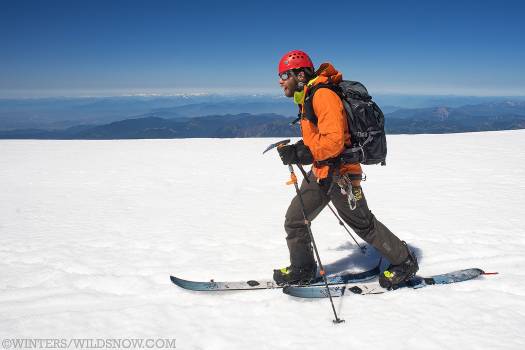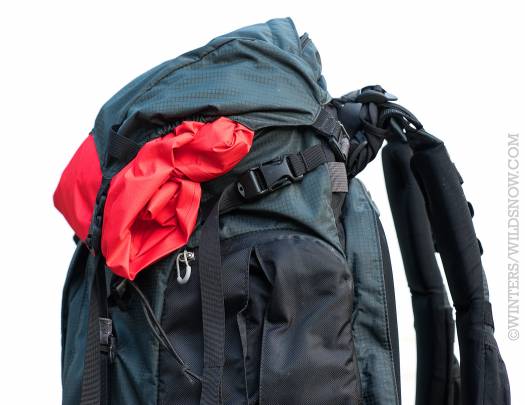Zachary Winters
What’s convenient about taking a professional camera, several lenses, filters, and a tripod into the backcountry? Not much. And unfortunately for those of us who think the backcountry is the most beautiful place to take photos, there aren’t a lot of great options available for toting around the necessary gear.
A camera carrying solution for real use in the backcountry has to protect your equipment and keep it quick on the draw, all while remaining a functional piece of gear for your day’s objectives.
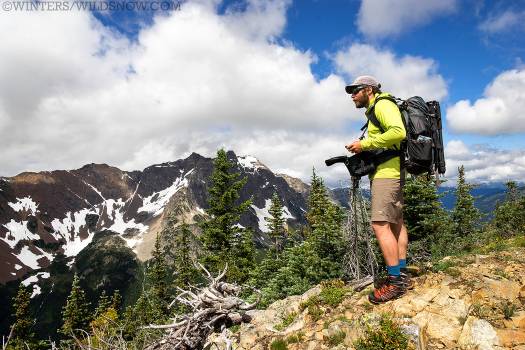
The MindShift Rotation 180 Professional configured and packed for 5 days of hiking and photography in the North Cascades. Click all images to enlarge.
The industry offers plenty of camera packs that do a great job at keeping gear safe and organized, but most require taking the pack off every time a photo-op arises. The holster case on a chest harness option keeps your camera handy, but I find the set-up so annoying that it gets buried in my pack more often than I’d like to admit.
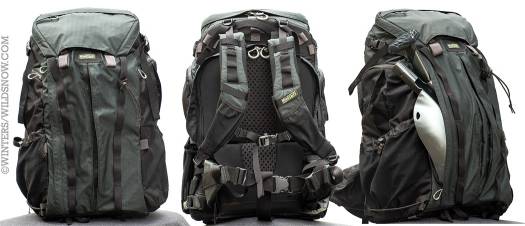
Front and back view of the MindShift Rotation 180 Professional. The back zippered pocket is a perfect place for an avalanche shovel.
The gurus at MindShift Gear have been working hard at this paradox, and the two packs they’ve come up with will certainly demand attention from solution hungry adventure photographers. The Rotation 180 Panorama and the Rotation 180 Professional
both feature their genius rotating belt pack. Simply unclip a magnetic buckle, pivot your waist belt to access the camera pack, and when your done just reverse and carry on skiing, climbing, or hiking without the hindrance of a front pack. It’s about time backcountry photographers have a good solution to keeping their camera rapidly accessible, protected, and out of the way!
The Rotation 180 Professional is the larger and more featured of the two offerings
(see Lisa’s review of the smaller “Panorama” pack). The r180 Pro measures in at 37.5 liters, with about 8L of space in the belt pack, and about 29.5L in the rest of the pack. For me, this has been just about the right size for ski mountaineering with glacier kit, crampons, etc. and for lightweight backpacking for up to five days. For day hiking and minimal spring ski tours the volume may be a bit overkill, but the pack holds it shape so well when under-filled that I expect it will suite these needs just fine. I anticipate the volume will be just about right for winter ski touring and possibly for lightweight hut skiing (though I tend to pack a 50L to the brim for extended hut trips). I’ve also found that using the belt pack alone as a lumbar pack has started to take the place of my daily camera case. It’s hands free, doesn’t swing around on my shoulder, and can pivot around behind me just like when used with the pack. Third party lens cases can be attached to the waist belt to add room if using as a stand-alone lumbar pack.
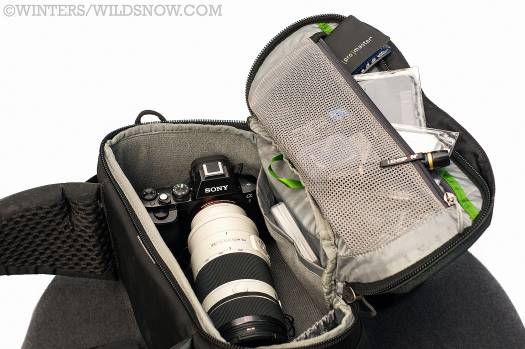
With or without the rest of the pack, the belt pack is a perfect camera case. I love the clear zippered pocket for filters, lens cloths, etc.
Versatility aside, MindShift Gear’s rotating belt pack has literally reduced the number of decisions I have to make in the mountains regarding my camera. No more burying a camera case in my pack because “the light isn’t that great yet”, or daring to climb a steep couloir knowing there’s no way I could self arrest with this rattrap on my chest. But enough rejoicing, let’s dig into the features.
The belt-pack itself measures 13” x 7” x 7.5” and is fully customizable to fit your photo kit with removable inserts. The underside of the zippered lid has a mesh pocket for filters, lens cloths, and small accessories. The outside of the belt-pack also has a zipper pocket where I keep memory cards and extra batteries, but I prefer the see-through mesh pocket for things I need in a hurry. When I don’t feel the need to load up on lenses, the belt-pack is a very handy space to keep other items like snacks, a GPS unit, or sunglasses readily accessible.
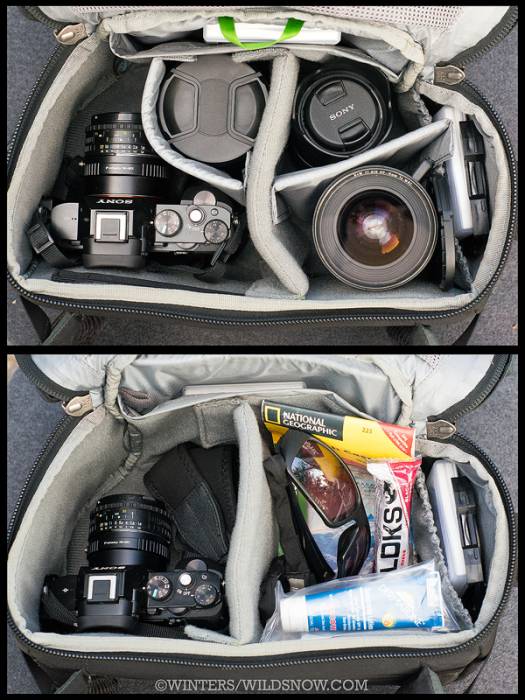
Configured for maximizing or simplifying photo gear, the belt pack is easily modifiable to suite different needs. I love a safe and accessible place to stash my shades or GPS.
The rest of the storage compartments, I’ll admit, took some getting used to for me. Outside of photo storage, I tend to be the kind of user that prefers a pack with one big compartment and very minimal pockets (i.e. Cilogear Worksack with no lid). Instead, the MindShift pack has a 12” x 14” x 8” rectangular main compartment and oodles of zippered and mesh pockets. But the more I use this pack, the more I start to remember where I put things and jive with its layout. For example, the zippered back pocket is perfect for shovel and probe storage, or for a wet layer. It is pleated so it expands to allow over-stuffing. I find myself using the zippered and mesh side pockets for water bottles so any leaks aren’t right above my expensive camera and lenses (though the main compartment does have a great hydration sleeve). The pack comes with a removable sling (basically a hanging pocket) that attaches to the back of the pack to be used as a tripod sleeve. Looking for ways to shave weight, I removed it because my larger tripod doesn’t fit especially well (Feisol Carbon Fiber CT-3342). Using the straps included with the pack, attaching my tripod without the removable sling was easy and solid. The r180 Pro also includes a well-designed rain cover that allows you to rotate the belt pack while the rain cover is in use. If you like rain covers, it’s a great bonus that this comes standard. For me however, I decided this was an easy way to save weight and opted to trust the forecast instead. That said, I always recommend carrying a heavy duty Ziploc for electronics and optics (or a dry bag if wet weather is imminent) – with or without a rain cover.
If you upgrade to the Deluxe Edition, the r180 Pro comes with several other accessories to bolster your configuration options: Extra removable straps, a padded insert for organizing camera gear in the upper compartment, a removable top pocket, and a tripod suspension kit. I found the extra straps critical for configuring a solid ski carry, and the top pocket is very useful for expanding the volume enough for overnight use. The padded organization insert is a perfect way to take all your lenses along, but leaves little space for other gear, so it works best when photography is the main activity. For day hiking photography missions, this insert keeps you well organized and keeps the belt pack from being over-packed with lenses, but I found myself leaving it behind when backpacking or ski mountaineering. The tripod suspension kit is designed to carry a tripod extended and hands free, keeping it ready for use without taking the pack off. Because it’s a bit unwieldy even in its hands-free configuration, I’ll probably stick to carrying the tripod fast to the pack except for those trips where I’m focusing on landscape and night photography more than anything else.
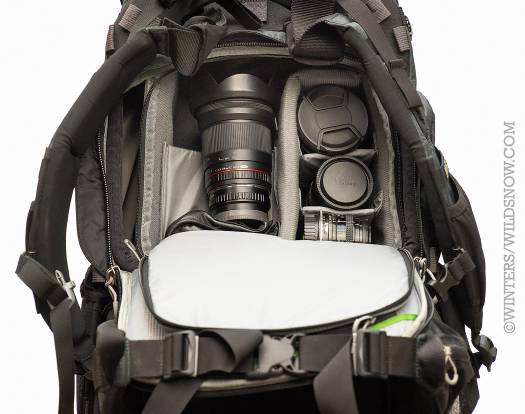
The padded insert helps organize and protect camera gear, and is removable when space for other gear is priority.
On top of picking and choosing between features to utilize or leave behind, I made a few small mods. By adding just one attachment strap (available in the Deluxe Edition or separately) I was able to configure a solid A-frame style ski carry. While the frame isn’t designed for extremely heavy loads, it got the job done for a three-mile trail approach to the summer snow line on Mt. Baker. My only true gripe about the ski carry is that the belt pack cannot be rotated with skis in an A-frame setup. While I prefer an A-frame carry, it is easy to configure a diagonal carry as an alternative that leaves the belt pack accessible. To dial in the ice axe carry, I added an elastic loop with a cord-lock to secure the axe shaft to the back of the pack. The two traditional axe loops are simple and functional. I would add a second loop and cord lock to carry two tools. Finally, I was able to save a little weight (just under 2 ounces) by eliminating extraneous straps. The waist belt, shoulder straps, load lifters, and back panel strap (used in ski carry) were all long enough to warrant a little trimming. Overall I was incredibly pleased with the customizability of the pack, which meant less scissors and more flexibility to change my mind about a feature in the future.
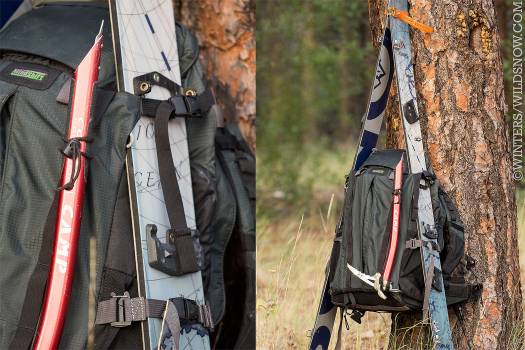
After a few small tweaks, the MindShift Rotation 180 Professional is happy to tote your skis or splitboard and an ice axe (or two). Note the upper axe attachment is easily added, but does not come with the pack.
A

It’s always worth it to have the right gear along. Without a functional camera pack it can be temping to leave behind the proper tools to make memorable imagery.
As I have it configured in this review, the MindShift Rotation 180 Professional weighs in at 5.1 lb (2.3 kg). While it may not be the lightest ski mountaineering pack in the world, keep in mind the weight savings of ditching your alternative. My holster case and chest harness weigh 18.5oz empty.
The MindShift Rotation 180 Professional is one of most effective solutions on the market for backcountry photographers. It is easily customizable to get the job done whether it is ski mountaineering, backpacking, day hiking, or ski touring. The rotating belt pack is pure genius and (if you can’t tell) I’m ecstatic about ditching my camera case chest harness!
Dimensions and specs:
Pack Exterior: 13.5″ W x 22.5″ H x 10.5″ D (57 x 27 x 34 cm)
Upper Compartment Interior: 12″ W x 14″ H x 8″ D (30.5 x 35.5 x 20.3 cm)
Belt Pack Exterior: 13″ W x 7″ H x 7.5″ D (33 x 17.8 x 19 cm)
Belt Pack Interior: 12.5″ W x 7″ H x 7″ D (31.7 x 17.8 x 17.8 cm)
Backpack Volume: 1807 cubic inches (29.63 liters)
Beltpack Volume: 480 cubic inches (7.87 liters)
Total Volume: 2287 cubic inches (37.5 liters) (without accessories)
Beltpack Weight: 1.8 lbs (0.8 kg)
Extra Lid Weight: 4.8 oz (with straps)
Total Weight (as advertised): 5.3 lbs (2.5 kg)
Total Weight (configured as described in this review): 5.1 lb (2.3 kg)
(WildSnow.com guest blogger Zachary Winters is an avid coffee drinker, splitboarder, photographer, and rock climber who calls the North Cascades home. Living in the small town of Mazama, Washington, you could encounter him on the trail working as a Wilderness Ranger in the summer months, and the rest of the year he is chasing good snow, working on his photography, and looking for wolverines. Check out more of his outstanding photos here.)
Beyond our regular guest bloggers who have their own profiles, some of our one-timers end up being categorized under this generic profile. Once they do a few posts, we build a category. In any case, we sure appreciate ALL the WildSnow guest bloggers!

